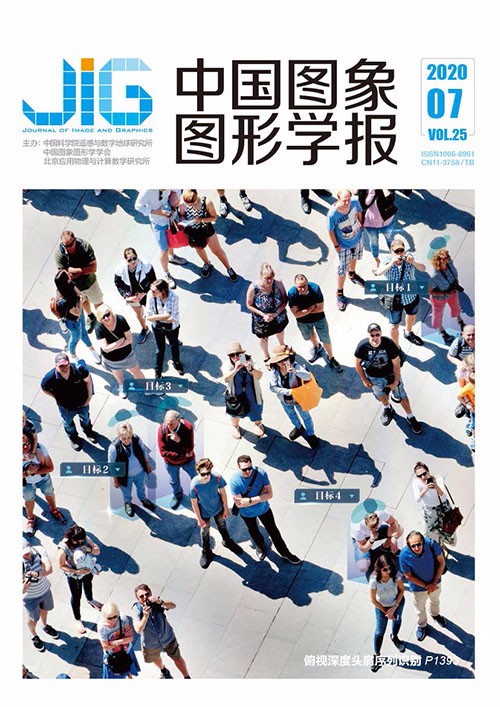
乳腺超声图像中易混淆困难样本的分类方法
摘 要
目的 超声诊断常作为乳腺肿瘤首选的影像学检查和术前评估方法,但存在良恶性结节的图像表现重叠、诊断严重依赖医生经验,以及需要较多人机交互等问题。为减少误诊和不必要的穿刺活检率,以及提高诊断自动化程度,本文提出一种端到端的模型,实现结节区域自动提取及良恶性鉴别。方法 就超声图像散斑噪声问题使用基于边缘增强的各向异性扩散去噪模型(edge enhanced anisotropic diffusion,EEAD)实现数据预处理,之后针对结节良恶性特征提出一个改进的损失函数以增强鉴别性能,通过形状描述符组合挖掘因形状与其他类别相似从而易导致错判的困难样本,为使该部分困难样本具有更好的区分性,应用改进的损失函数,并在此基础上构建困难样本形状约束损失项,用来调整形状相似但类别不同样本间的特征映射。结果 为验证算法的有效性,构建了一个包含1 805幅图像的乳腺超声数据集,在该数据集上具有5年资历医生的平均判断准确率为85.3%,而本文方法在该数据集上分类正确率为92.58%,敏感性为90.44%,特异性为93.72%,AUC (area under curve)为0.946,均优于对比算法;相对传统Softmax损失函数,各评价指标提高了5% 12%。结论 本文提出了一个端到端的乳腺超声图像分类方法,实用性强;通过将医学知识融合到优化模型,增加的困难样本形状约束损失项可提高乳腺肿瘤良恶性诊断的准确性和鲁棒性,各项评价指标均高于超声科医生,具有临床应用价值。
关键词
Classification method for samples that are easy to be confused in breast ultrasound images
Du Zhangjin1, Gong Xun1, Luo Jun2, Zhang Zhemin1, Yang Fei1(1.School of Information Science and Technology, Southwest Jiaotong University, Chengdu 610000, China;2.Sichuan Academy of Medical Sciences, Sichuan Provincial People's Hospital, Chengdu 610072, China) Abstract
Objective Ultrasound is the primary imagological examination and preoperative assessment for breast nodules. In the qualitative diagnosis of nodules in breast ultrasound images, the breast imaging and reporting data system (BI-RADS) with six levels is commonly used by physicians to evaluate the degree of malignant breast lesions. However, BI-RADS evaluation is time-consuming and mostly based on the morphological features and partial acoustic information of a lesion. Diagnosis relies heavily on the experience of physicians because of the overlapping image expression of benign and malignant breast nodules. The diagnostic accuracy of physicians with different qualifications can differ by up to 30%. Therefore, misdiagnosis or missed diagnosis can easily occur, increasing the needless rate of puncture biopsy. The current computer-assisted breast ultrasound diagnosis requires considerable human interactions. The automation level is low, and accuracy is unfavorable. In recent years, the deep learning method has been applied to the visual tasks such as medical ultrasound image classification and achieved good results. This study proposes an end-to-end model for automatic nodule extraction and classification. Method An ultrasound image of the breast is the result of using ultrasonic signals that are reflected by ultrasound when it encounters tissues in the human body. Given the limitation of the imaging mechanism of medical ultrasound, noise interference in breast ultrasound images is typically severe and mostly affected by additive thermal and multiplicative speckle noises. Thermal noise is caused by the heat generated by the capturing device and can be avoided via physical cooling. Speckle noise is a bright and dark particle-like spot formed by the constructive and destructive interference of reflected ultrasonic waves; it is unavoidable because of the principle of ultrasound imaging. For the model of speckle noise in an ultrasound image, this work uses edge enhanced anisotropic diffusion(EEAD) to remove noise as a preprocessing step. Then, an improved loss function is proposed to enhance the discriminant performance of our method with respect to nodules' characteristics of benign and malignant parts. We use a combination of shape descriptors (concavity, aspect ratio, compactness, circle variance, and elliptic variance) to describe difficult samples with similar shapes to other classes, which can be apt to misjudgment. To make such difficult samples more distinguishable, an improved loss function is developed in this study. This function builds the shape constraint loss term of difficult samples to adjust feature mapping. Result A breast ultrasound dataset with 1 805 images is collected to validate our method. For this dataset, the average diagnosis accuracy(AUC) of physicians with five-year qualifications is 85.3%. However, the classification accuracy, sensitivity, specificity, and area under the curve of our method are 92.58%, 90.44%, 93.72%, and 0.946, respectively, which are superior to those of the comparison algorithms. Moreover, compared with the traditional softmax loss function, the performance can be increased by 5%—12%. Conclusion In this study, the classification of benign and malignant nodules in two-dimensional ultrasound images of the breast is the main research content, and the advanced achievements in machine learning, computer vision and medicine are taken as the technical support. Aiming at the problems of poor quality of two-dimensional ultrasound images of the breast, small proportion of lesions, overlapping of benign and malignant nodule images, and heavy dependence on doctors' experience in diagnosis, this paper improves the data preprocessing level and algorithm At the level of data preprocessing, the original breast ultrasound data is denoised and expanded to improve the quality of the data set and maximize the utilization of the data set; at the level of algorithm improvement, the model training process is dynamically monitored to dynamically mine difficult samples and regularize the distance between classes to improve the classification effect of benign and malignant. In this study, an end-to-end ultrasound image analysis model of the breast is proposed. This model is pragmatic and useful for clinics. By incorporating medical knowledge into the optimization process and adding the shape constraint loss of difficult samples, the accuracy and robustness of breast benign and malignant diagnoses are considerably improved. Each evaluation result is even higher than that of ultrasound physicians. Thus, our method has a high clinical value.
Keywords
breast ultrasound image breast tumor classification deep learning loss function computer aided diagnosis(CAD) difficult sample
|



 中国图象图形学报 │ 京ICP备05080539号-4 │ 本系统由
中国图象图形学报 │ 京ICP备05080539号-4 │ 本系统由